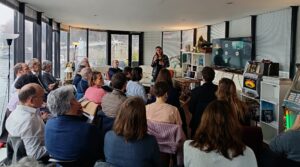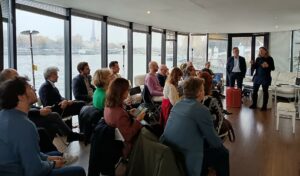💡 Integrating biodiversity into transport infrastructure: best practices and innovations
💡 Integrating biodiversity into transport infrastructure: best practices and innovations
With expert speakers from the rail, maritime, road, and airport sectors, this second Futura-Mobility session on Biodiversity and Transport, held on May 21, 2025, provided an opportunity to discuss the solutions implemented by mobility systems to protect biodiversity and establish coexistence beneficial to all.
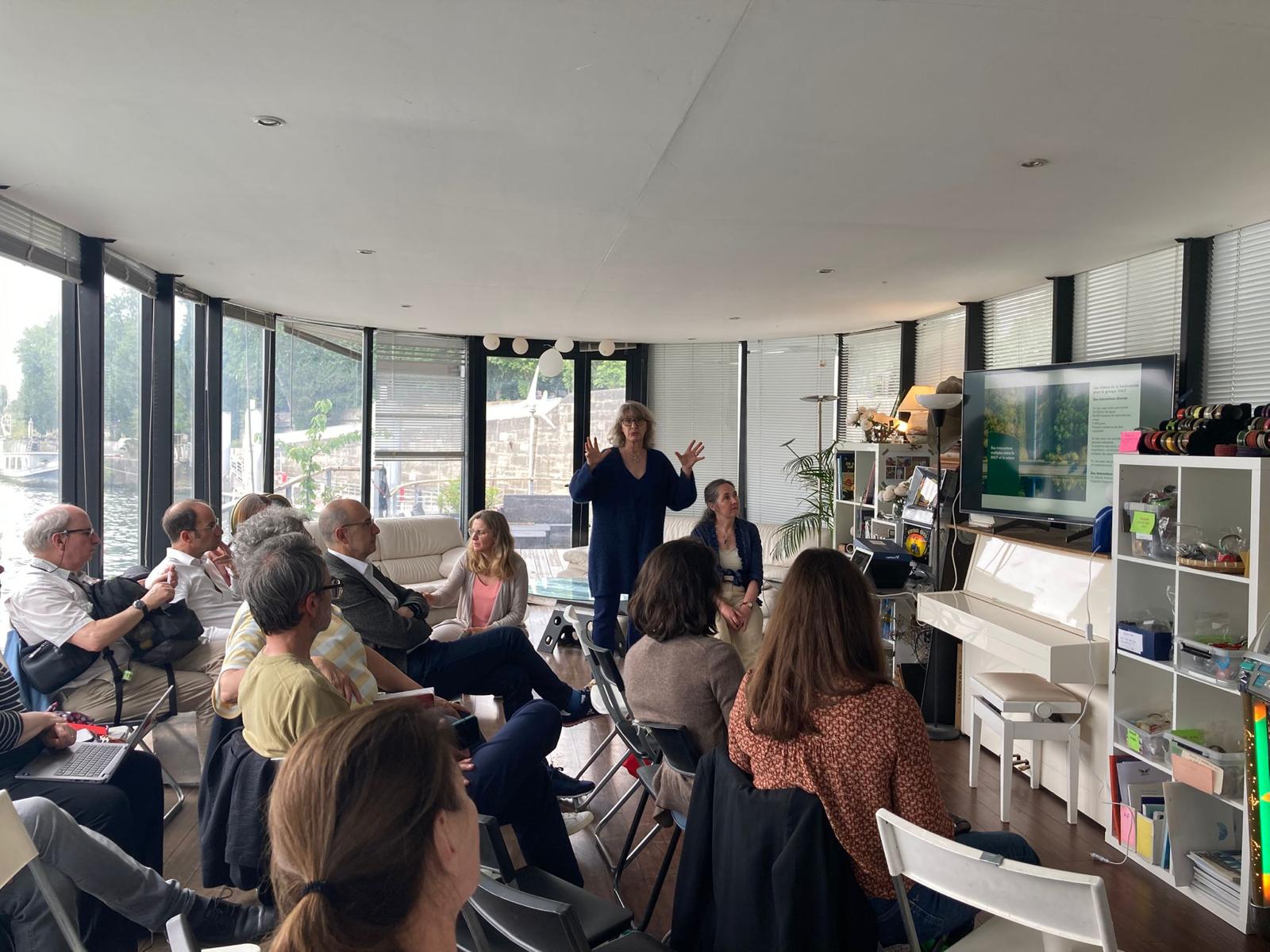
💶 ECONOMIC VALUATION
Valuating ecosystem services with ECOV4R
Presented by Dr Mike Image, chartered environmentalist and associate at AtkinsRéalis, and Marie-Claire Jalaguier, environmental scientist, AtkinsRéalis, the Ecosystem Valuation for Railways (ECOV4R) project focuses on the concept of valuing ecosystem services.
According to the project, the main ecosystem services provided by railway habitats are generally regulating or cultural: carbon sequestration by trees, vegetation, and soils; microclimatic cooling — especially important in urban areas; preventing erosion; provision of habitats for pollinators and rare species in areas along the tracks; visual screening and landscape improvement; recreational activities; etc. “In the U.K, this type of thinking is already well supported in other infrastructure-intensive sectors, such as water distribution services and the motorways,” points out Dr Image.
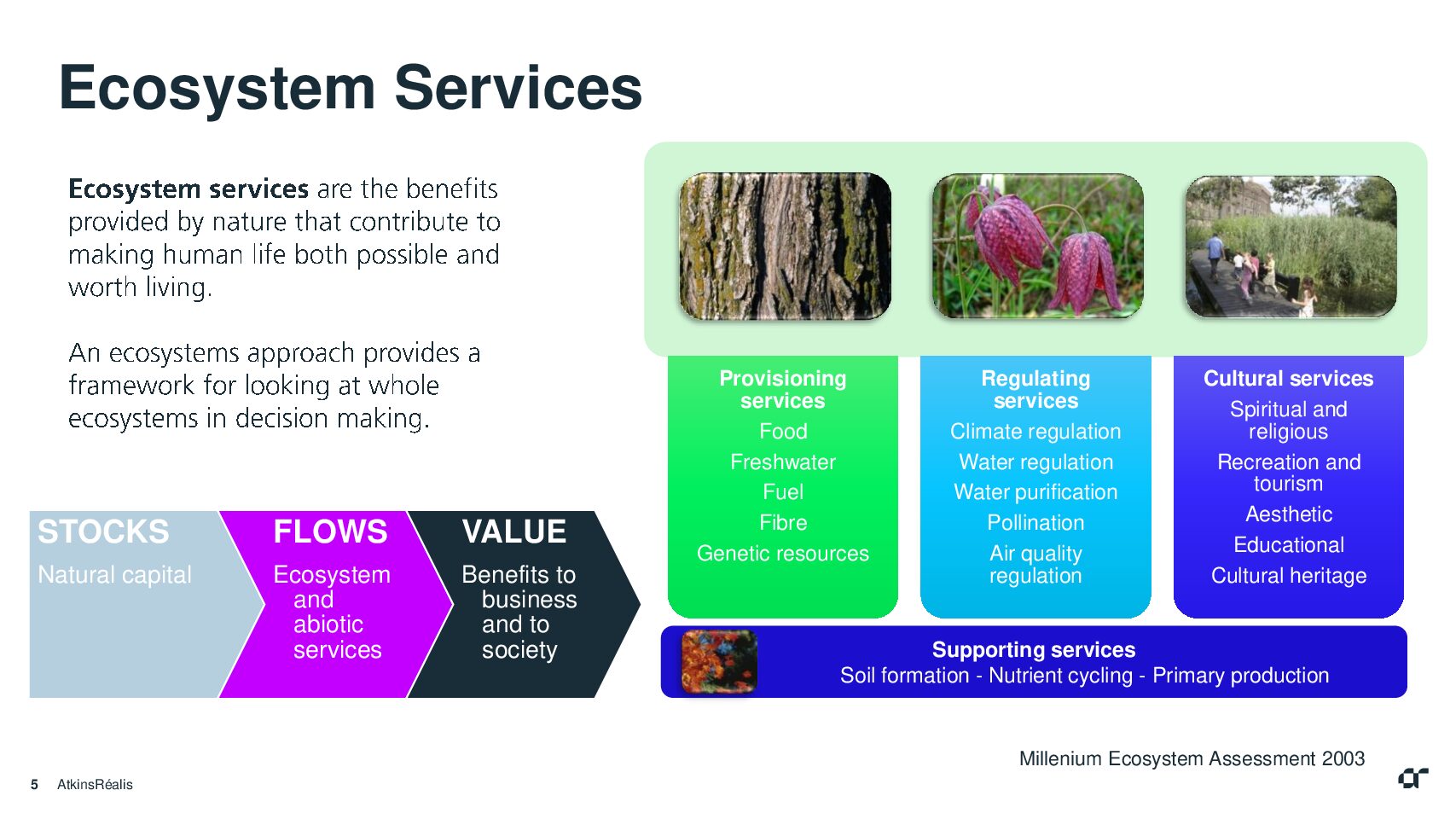
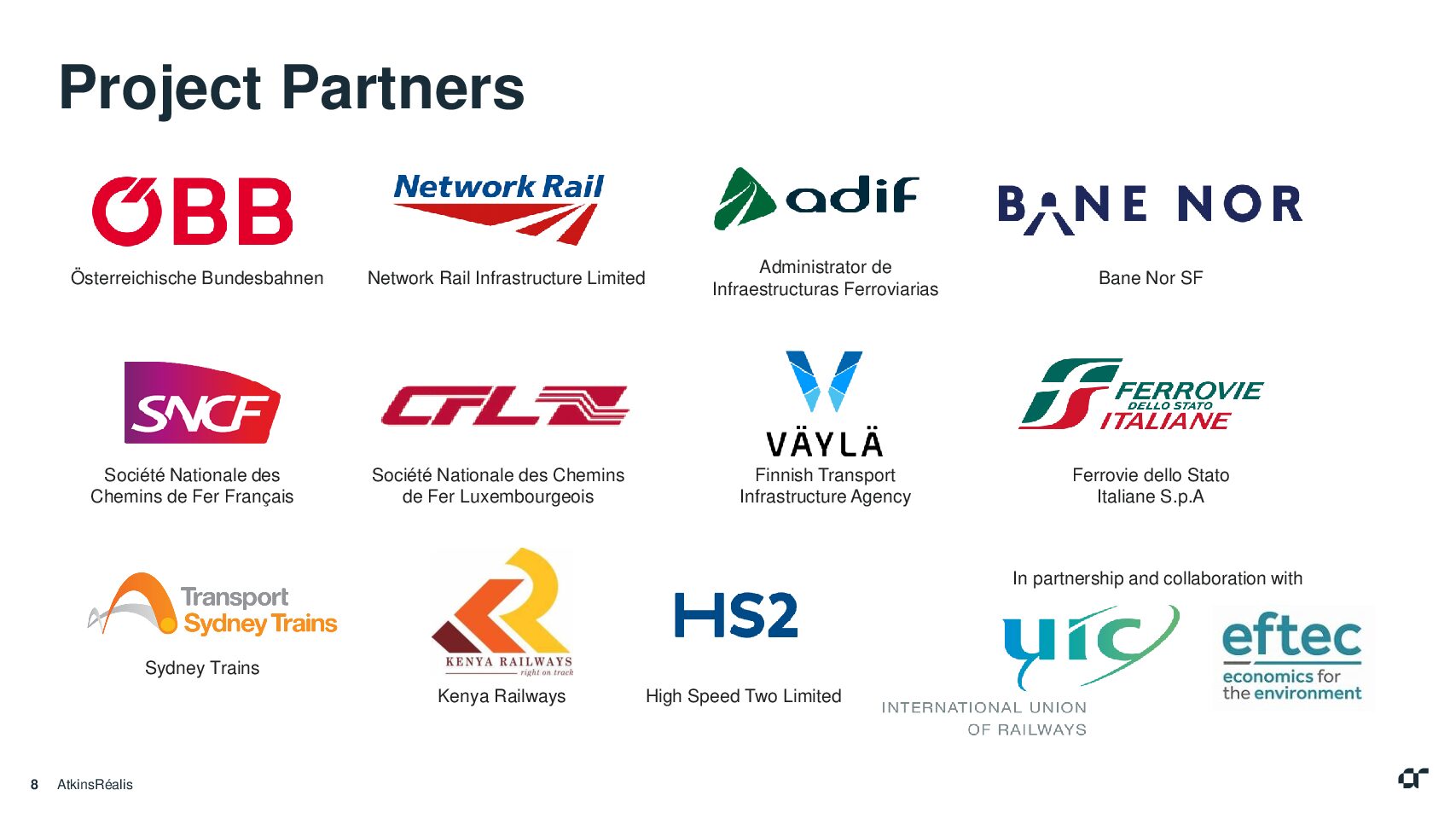
Between 2024 and 2026, the ECOV4R project and its partners (see illustration above) aim to provide a common global framework for valuing ecosystem services in the context of railway projects. To encourage more sustainable land management, this framework is designed to be pragmatic and use-able to non-specialists. The approach follows an established, phase-by-phase process, adapted to the specificities of rail:
– Phase A: Baseline assessment. A register of natural capital assets is drawn up (extent, quality, spatial configuration) and the ecosystem services they provide identified, including the ‘soft estate’, i.e., the surrounding landscape (verges, embankments, and surrounding vegetated land) beyond the railway line itself.
– Phase B: Identifying impacts on natural capital assets. This phase identifies the expected changes, after rail infrastructure works or improvements to the soft estate, to the register of natural assets (type, extent, quality, configuration of habitats).
– Phase C: Identifying impacts on ecosystem services. This phase identifies the expected changes in the ecosystem service provided by the natural assets as a result of the proposed project. The assessment needs to consider and select the ecosystem services most likely to be impacted. “At this stage, we also need to think about who is impacted. This is what is so interesting about rail projects because, since they connect urban areas, they can potentially impact a great many people,” adds Dr Image.
– Phase D: Valuing the impacts. The project leader first qualifies the changes and then, where possible, quantifies them (for example, tonnes of carbon dioxide sequestered for the climate regulation ecosystem service). If feasible, the benefits or dis-benefits can be monetised if data is available. To obtain an economic valuation, “we generally recommend using value transfer approaches based on secondary data provided by other organisations, like the U.K. government’s valuation of the tonne of carbon absorbed by habitat type, for instance,” explains Dr Image. “Economic valuation is crucial because it enables a cost/benefit analysis of projects.”
– Finally, Phase E: Using and interpreting results takes a step back to review the main conclusions, data used (e.g., degrees of uncertainty) and uses of the data (e.g., for reporting in Environmental Impact Assessments, the EU’s Corporate Sustainability Reporting Directive, and TNFD).
The ECOV4R framework can be used at any stage of a project, during the design phase before work begins or once a rail project has been completed, which can help monitor benefits.
The ECOV4R framework has been tested on two pilot projects since February 2025. One, on the Cotswold railway line in the U.K., is focusing on reducing flood risks and improving biodiversity. The other, in Spain, as a retrospective assessment of a completed high-speed rail upgrade between Valladolid and León, which will also assess the environmental mitigation measures of the project.
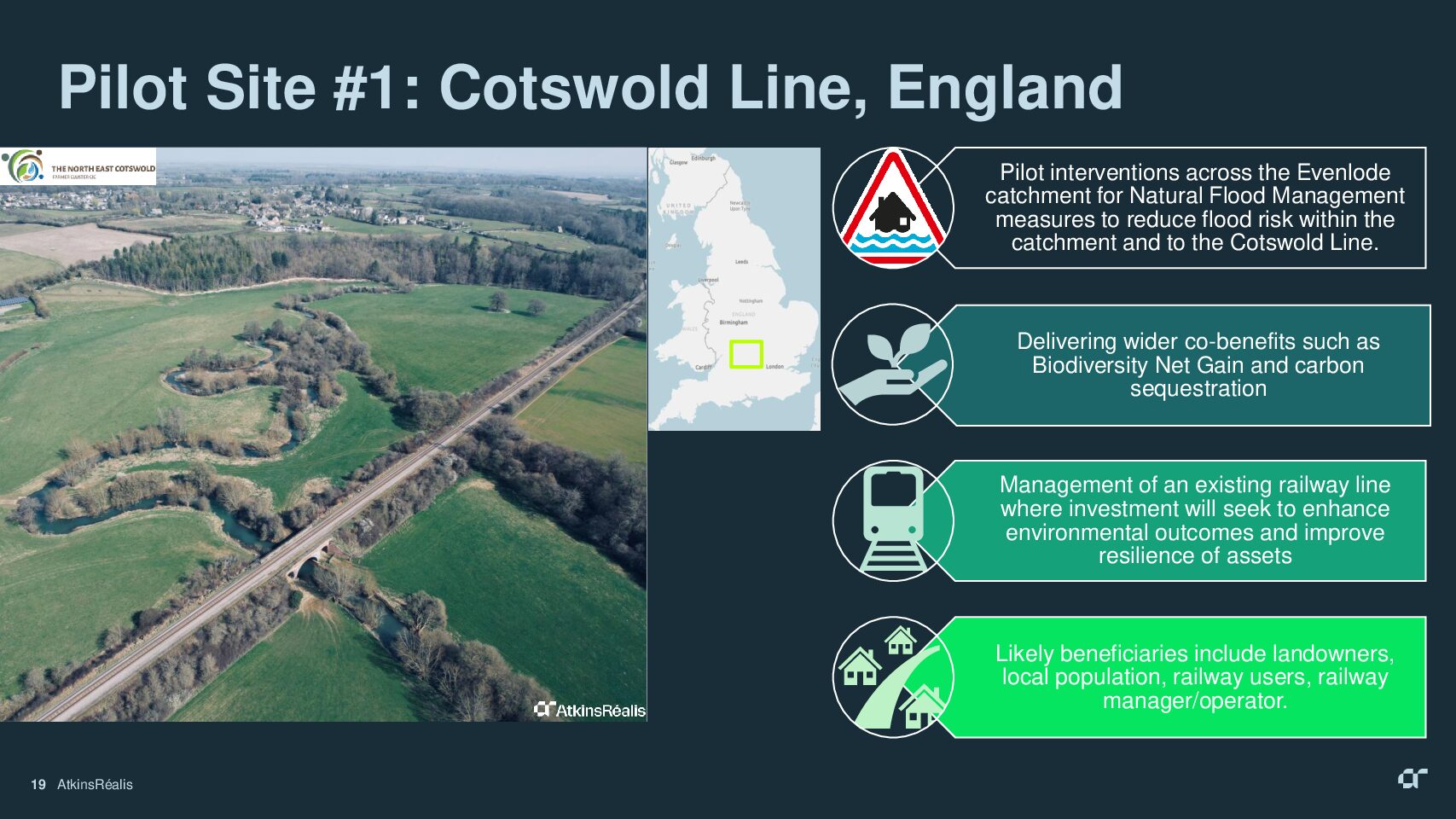
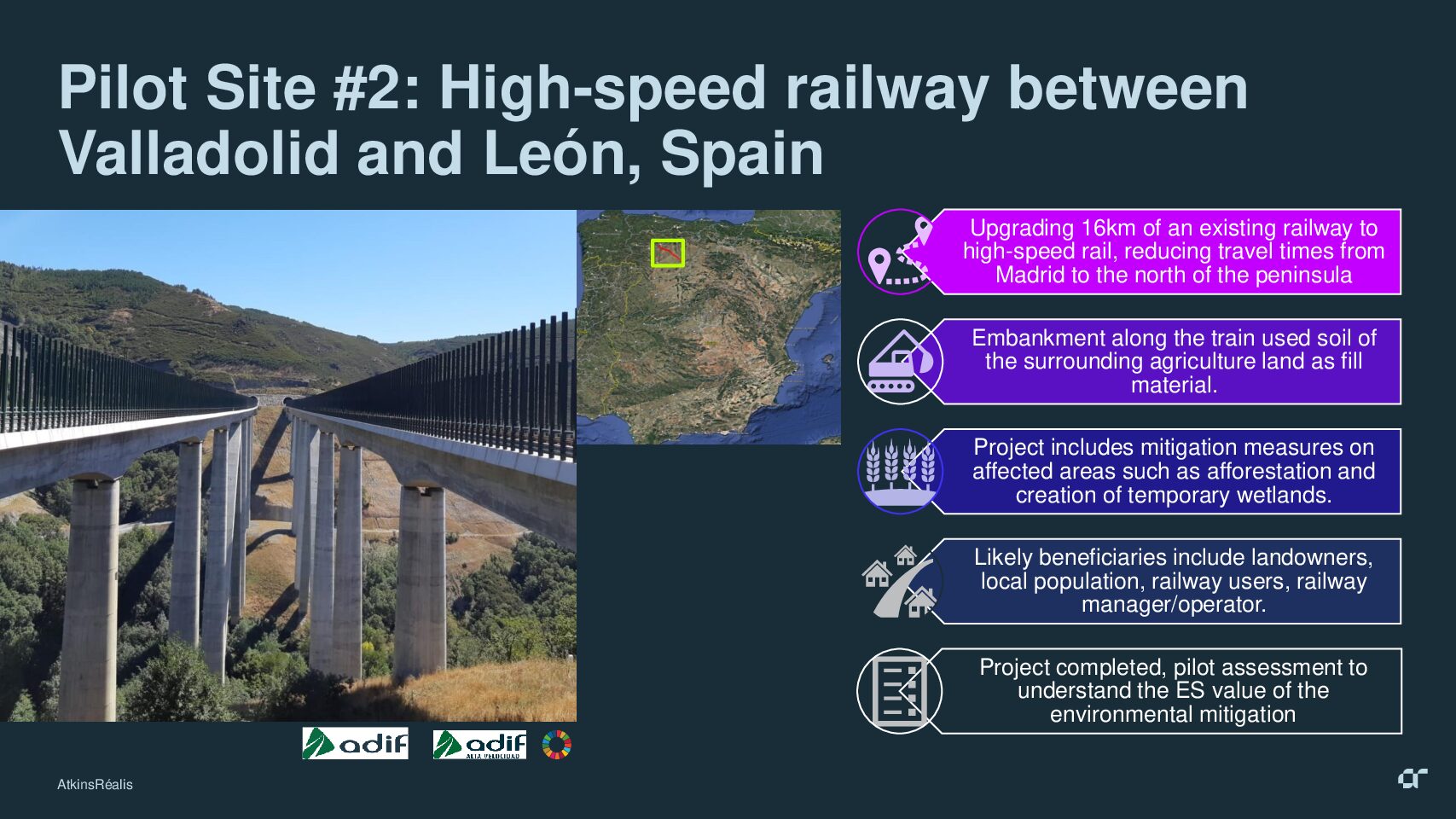
“Our pilot assessments will be completed by August 2025, and the final updates to the ECOV4R framework by October,” explains Ms Jalaguier. The final publication of the ECOV4R framework and an event to disseminate its content are scheduled for January 2026.
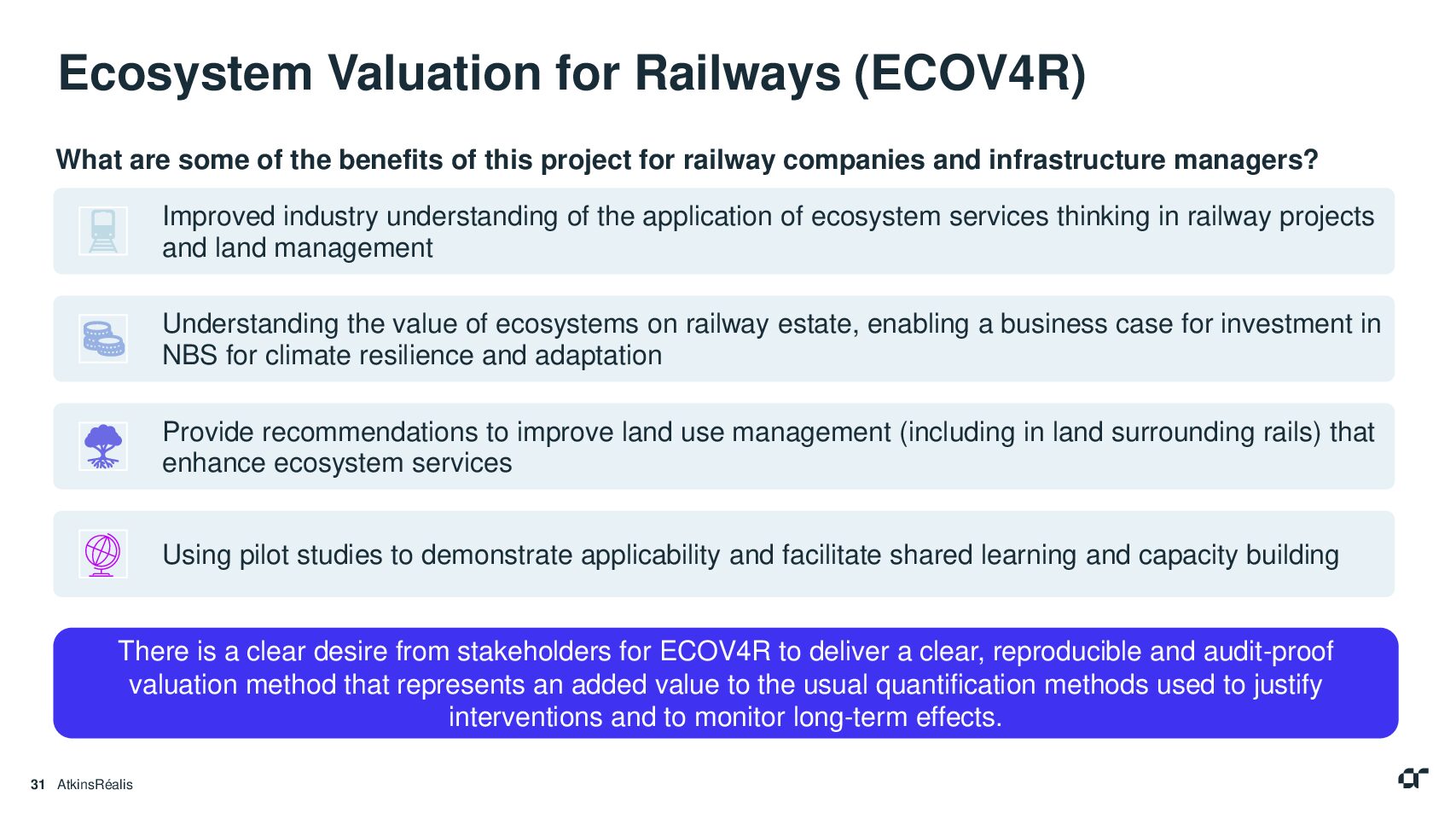
“The objectives of the ECOV4R project are to improve understanding of ecosystem services in the railway sector, build economic justifications for nature-based solutions, and provide an assessment method that can be reproduced and audited,” sums up Mike Image.
🚆 RAIL
Biodiversity: challenges and considerations at SNCF
In France, SNCF Group is responsible for 28,000km of railway lines, 88,000 hectares of green spaces (vegetated areas bordering transport infrastructure), 3,000 stations and several hundred industrial sites. When it comes to biodiversity, “we work on the overall impact of our activities across the entire Group, not in silos,” explains Anne Guerrero, director of the ecological transition delegation within the Group CSR Department (DRSE). “We identify the main interactions with biodiversity, determine the challenges and effects on biodiversity, and then prioritise actions. We work in the same way as for carbon, with scopes 1, 2 and 3.”
In scope 1 (direct impacts of the Group’s activities), the negative impacts are the destruction of habitats and species, land artificialisation, territorial fragmentation, the risk of collisions with wildlife and light pollution. On the positive side, the extent of SNCF’s land holdings, particularly its 88,000 hectares of green spaces, also represents opportunities for wildlife, particularly birds, bats, butterflies, reptiles, and amphibians. These spaces can play a role in diversifying habitats in certain environments, providing refuge, and serving as longitudinal ecological corridors.
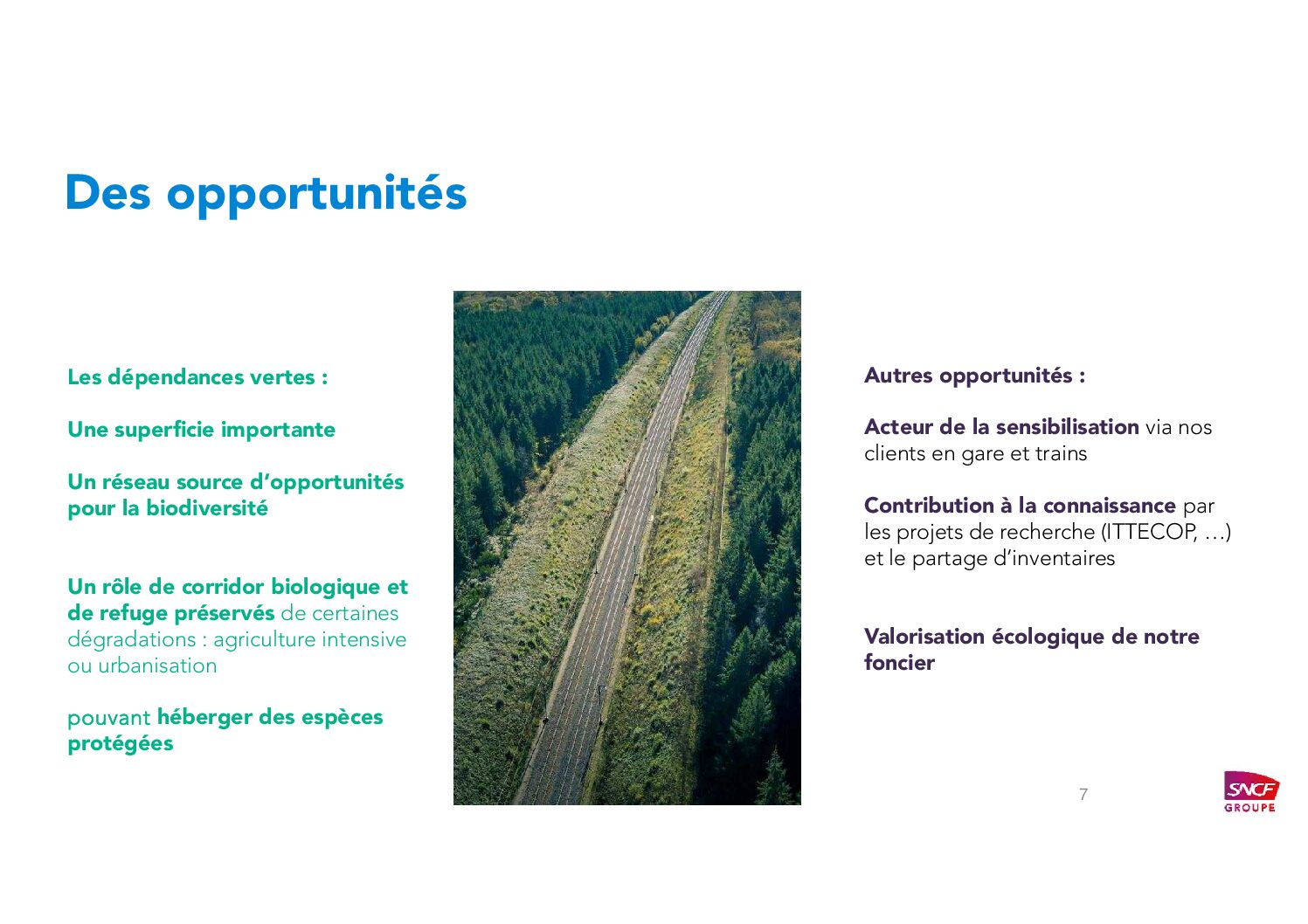
The Group is developing indicators for Scope 1. “Unlike carbon, which has a single indicator (greenhouse gas emissions), biodiversity has completely different scales of impact, from local to global, so it is impossible to use a single indicator,” explains Ms Guerrero.
Scopes 2 and 3 concern the impacts of the Group’s energy consumption and its value chain on biodiversity, such as GHG emissions, procurement, purchasing and consumption of raw materials, and water consumption. SNCF has tested the Global Biodiversity Score (GBS) tool developed by CDC Biodiversité to measure the footprint of these impacts on biodiversity.
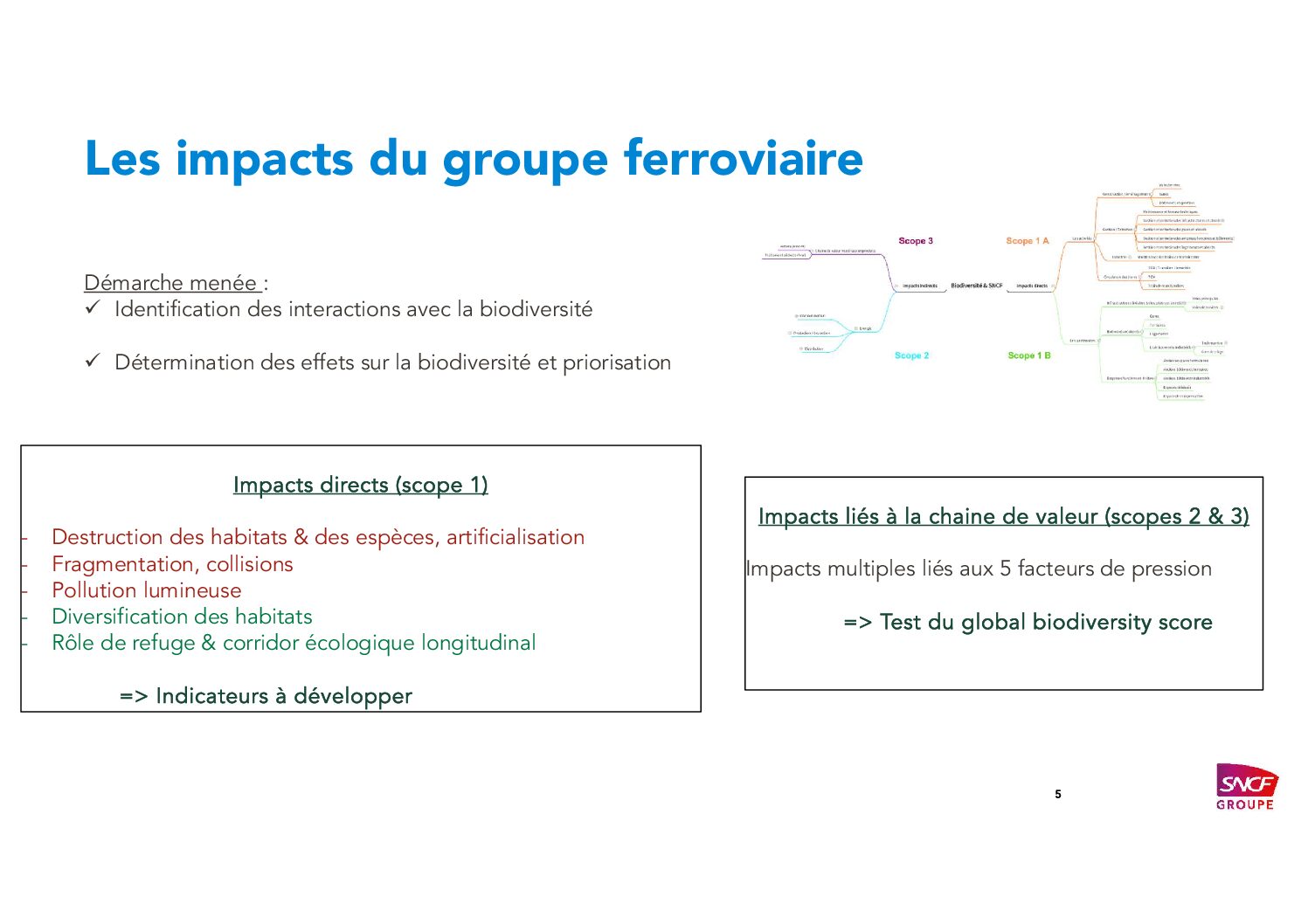
Preserving biodiversity is one of the three main pillars of the Group’s CSR strategy (alongside decarbonising its activities and developing the circular economy) to reduce the environmental impact of its activities. Its actions are especially reflected in commitments made since 2018 and renewed in 2024 as part of the voluntary Act4Nature International initiative.
Vegetation, water, land and buildings – actions taken in our direct operations (scope 1)
Along its linear infrastructure, SNCF Réseau is changing its vegetation management practices to better take biodiversity into account. Stopping the use of glyphosate at the end of 2021, for instance, is part of these efforts. “We are the first railway infrastructure manager in Europe to have done so!” says Cora Cremezi-Charlet, noise, air quality and biodiversity expert at SNCF’s DRSE. “Together with weed-control trains that target spray vegetation, this approach has really enabled us to drastically reduce our use of synthetic phytosanitary products.”
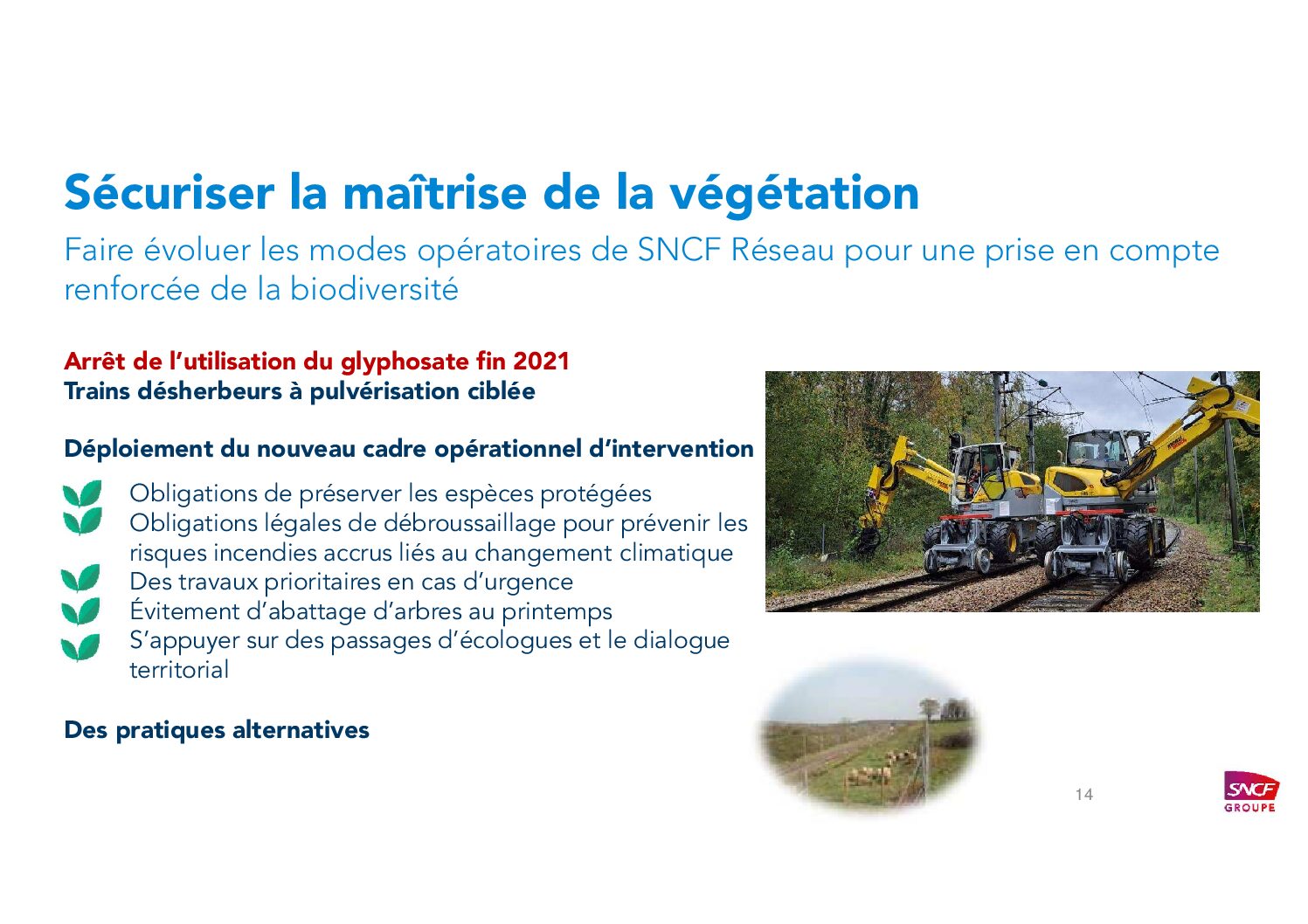
The Group also takes action to identify and reduce potential obstacles posed by its roads, bridges and other infrastructure to the movement of terrestrial and aquatic wildlife. In order to minimise disruption to animals, ecological continuity on land is restored through measures such as wildlife crossings and toad tunnels, which enable animals to cross safely. For waterways, whose beds may be impacted by bridge foundations, for instance, this work involves installing features like rock ramp structures that allow species to move freely once again.
In terms of train traffic, to prevent collisions with large wildlife, acoustic deterrent devices using new synthesised signals are currently being tested.
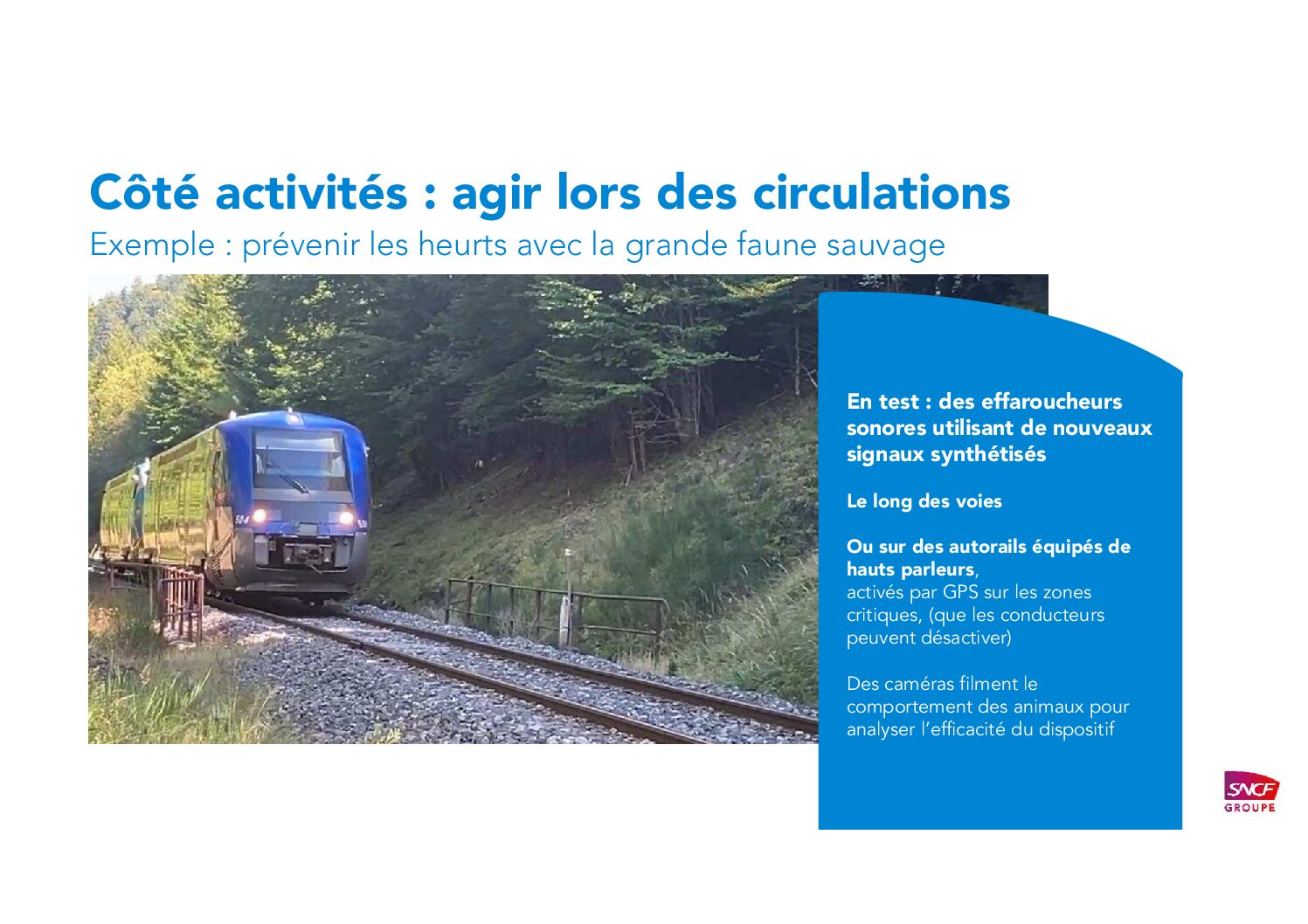
For several years now, awareness has been growing within the Group. Traditionally coming from SNCF Réseau, it has extended to other areas of activity. Gares & Connexions and SNCF Voyageurs, through their buildings and industrial facilities, can have a positive impact and provide solutions by greening roofs and forecourts and practising differentiated management, for instance.
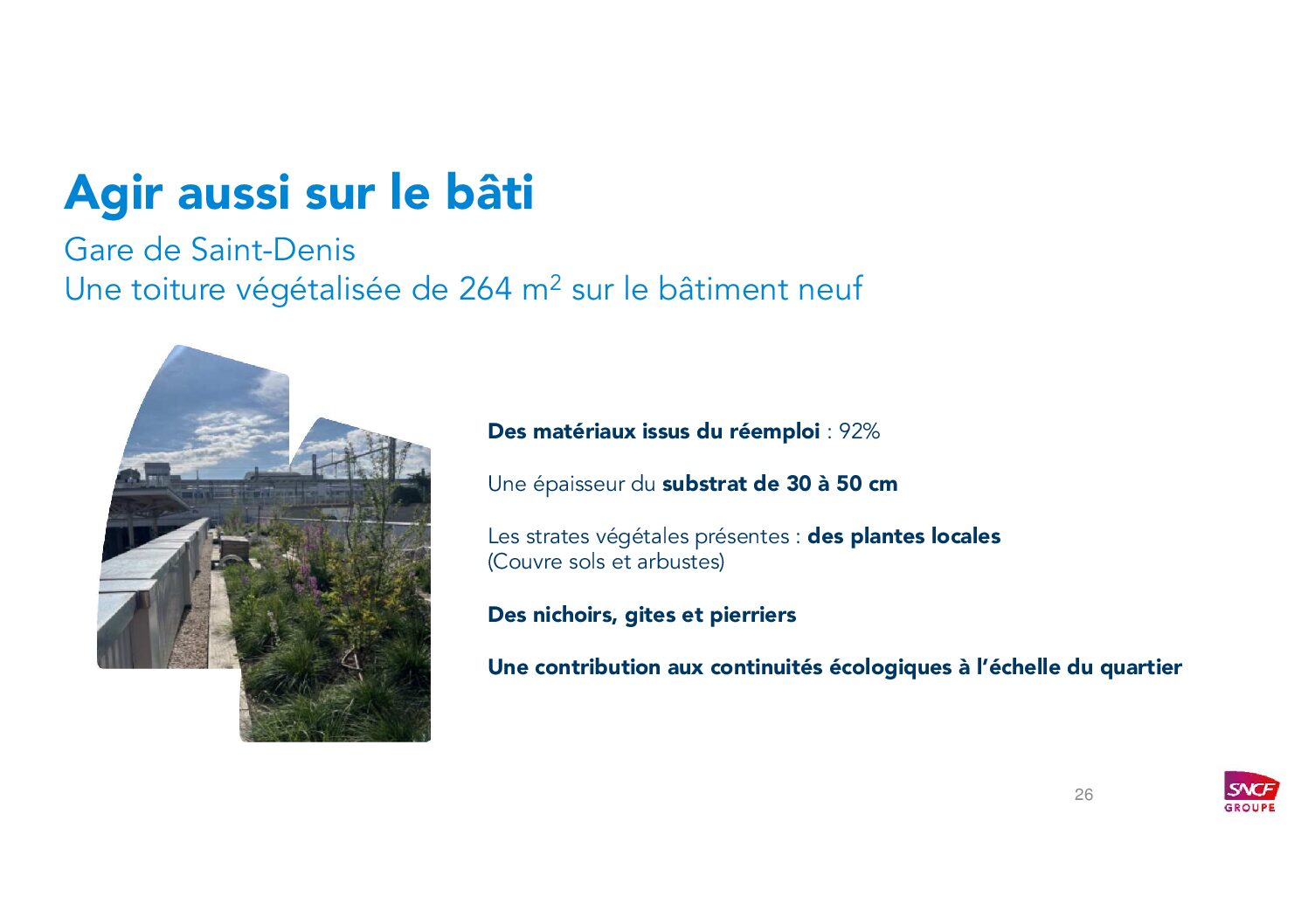
To support and reinforce this initiative, SNCF is also keen to change the mindset of its employees, “raising their awareness so they reconnect with the living environment around them at their workplace,” explains Ms Cremezi-Charlet. The campaign includes an in-house webinar, a regular newsletter, and other supporting materials.
⚓️ SEA
‘Blue Speeds’ to protect cetaceans
Thousands of commercial vessels criss-cross the globe. Maritime transport generates the majority of man-made underwater noise emissions, which impact marine life. As the number of vessels and their speeds increase, so too does the risk of collisions with cetaceans. In this context, and following Olivier Adam‘s presentation at the Futura-Mobility session Biodiversity and transport: a crucial challenge for the future of all, Aurore Morin, ‘Marine Conservation’ campaign manager at the International Fund for Animal Welfare (IFAW), presented actions by the organisation to tackle these ‘invisible’ issues.
IFAW supports several existing technologies that help protect marine life from these dangers: using innovative propellers to prevent cavitation (formation and implosion of water vapour bubbles caused by pressure variations), engine insulation and optimising the shape of ship hulls.
“Companies like Maersk have demonstrated these solutions can effectively reduce noise and improve energy efficiency,” explains Ms Morin. Yet they are costly, require significant financial investments, and involve immobilising ships, while the benefits only become apparent in the medium to long term.
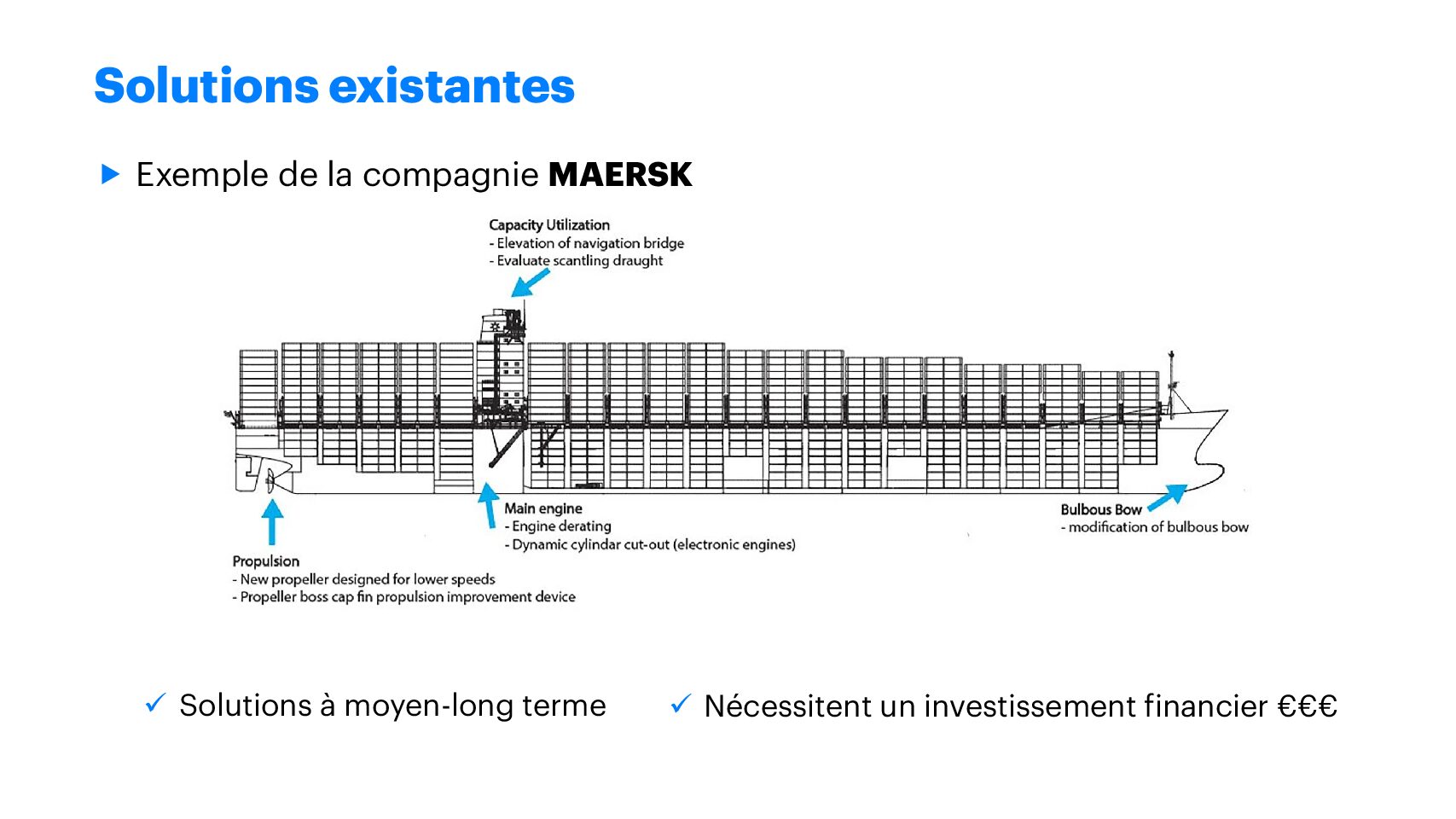
IFAW primarily promotes ‘Blue Speeds’. Launched in 2023, this solution aims to set a speed limit at 75% of a ship’s maximum design speed for its entire journey. According to IFAW, this corresponds to a 5-10% reduction in speed. “It’s an inexpensive solution that can be implemented immediately,” says Ms Morin. “It reduces underwater noise by 40% and collisions with whales by 50%, while also decreasing greenhouse gas emissions from ships. It generates fuel savings of between €3.4 and €4.5 billion annually.”
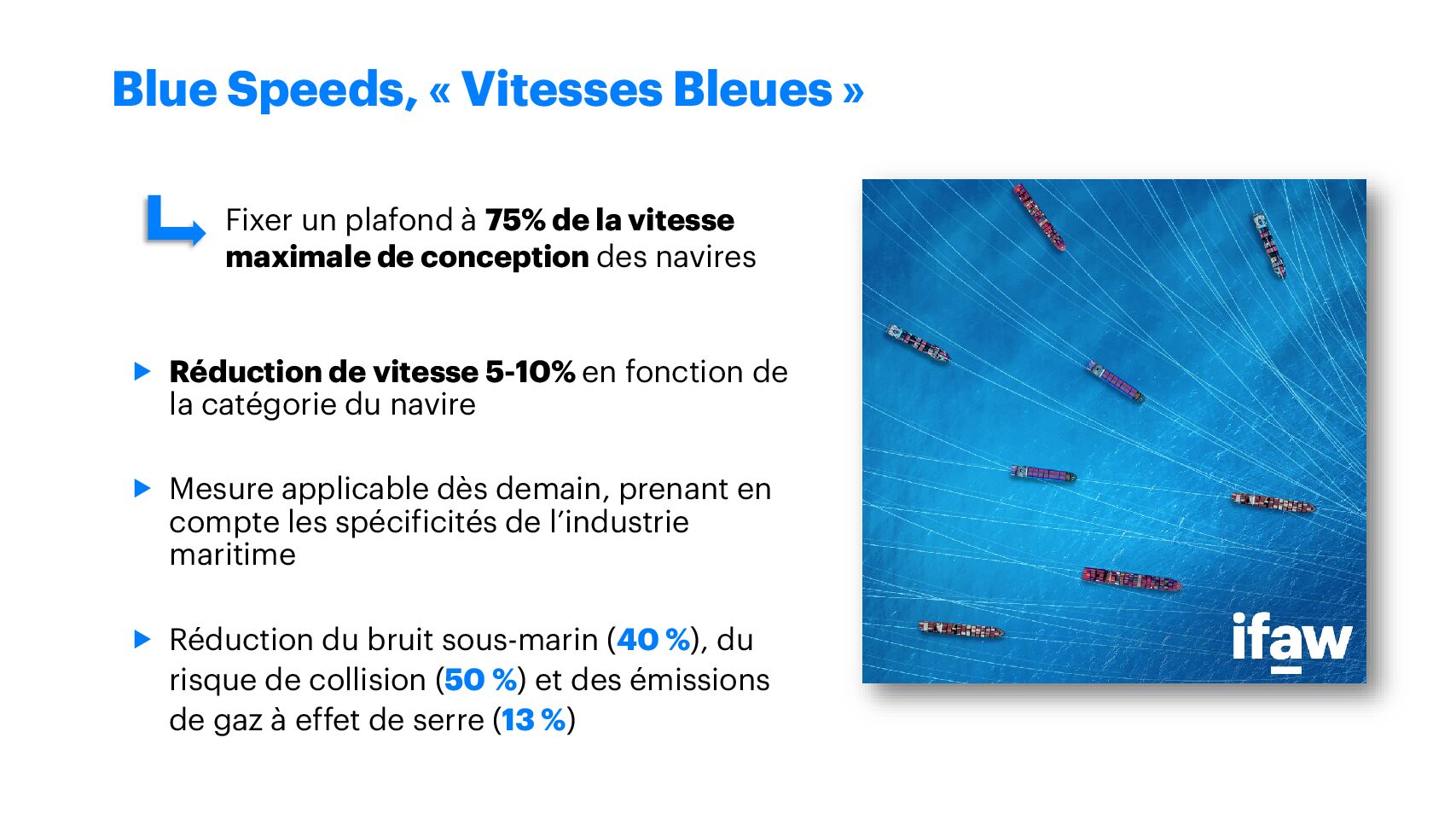
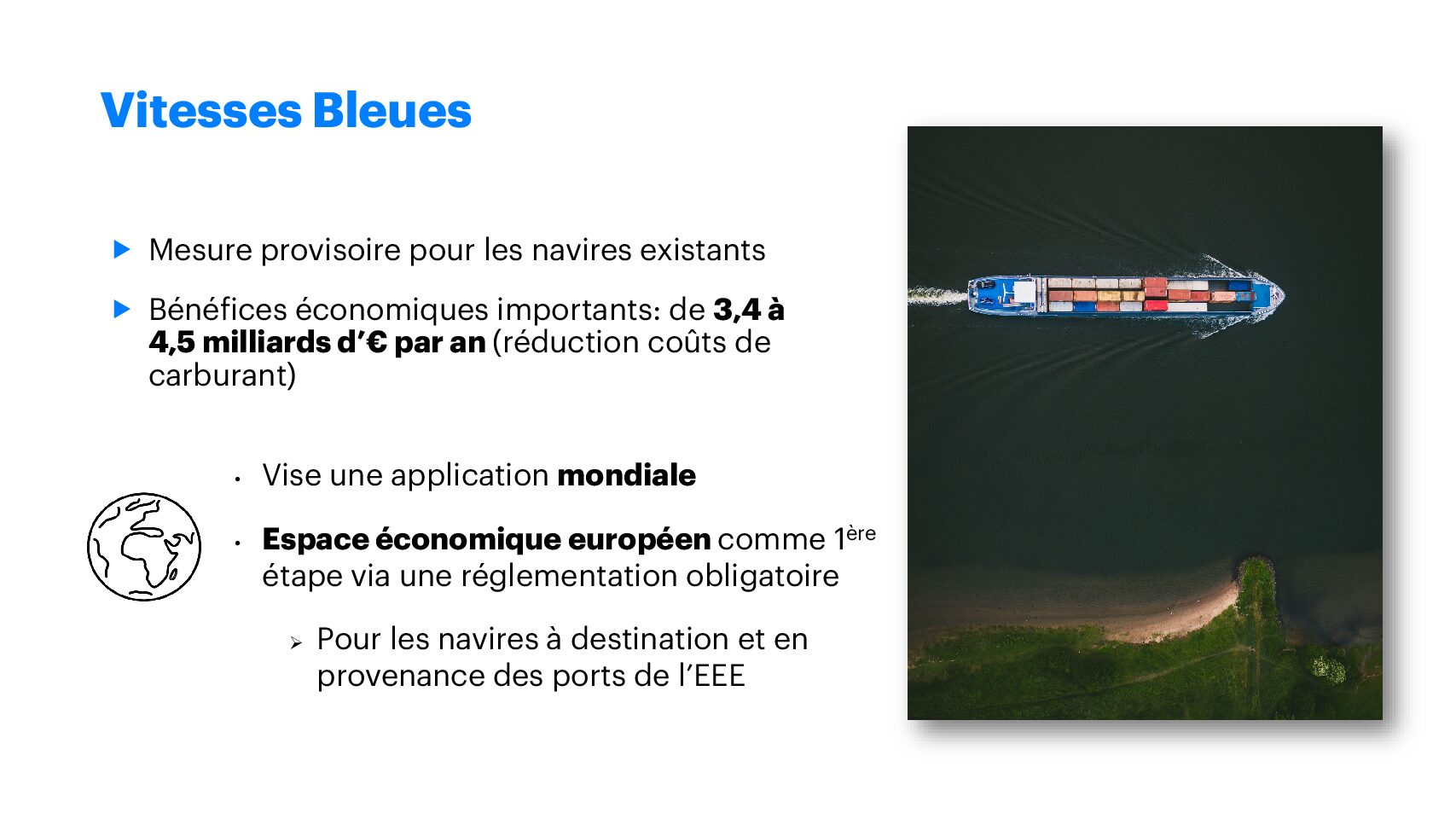
“We hope to make ‘Blue Speeds’ a reality around the world. But we have chosen to focus first on the European Economic Area,” says Ms Morin. Aware that voluntary reductions would create competitive distortions for companies, IFAW is calling for these speed regulations to be enshrined in European legislation.
🚗 LAND
Outlook for the Bison project
The European BISON project (Biodiversity & Infrastructures Synergies and Opportunities for European Transport Networks) is led by a consortium of 39 members from European and associated countries. It aims to integrate biodiversity into the development of infrastructure such as roads, railways, waterways, airports, ports, and energy transport networks.
In 2021 and 2022, BISON partners carried out a prospective study on integrating biodiversity into all linear transport infrastructure by 2050. Four scenarios for 2050 were drawn up and studied:
- Scenario 1: collapse of the transport system, emergency management.
- Scenario 2: sustainability remains a pipe dream, continuing with the usual trends.
- Scenario 3: decarbonisation and adaptation to climate change, what solutions to cut CO2 emissions?
- Scenario 4: cross-sectoral changes that address all planetary boundaries. This scenario is based on the systematic search for solutions to all challenges.
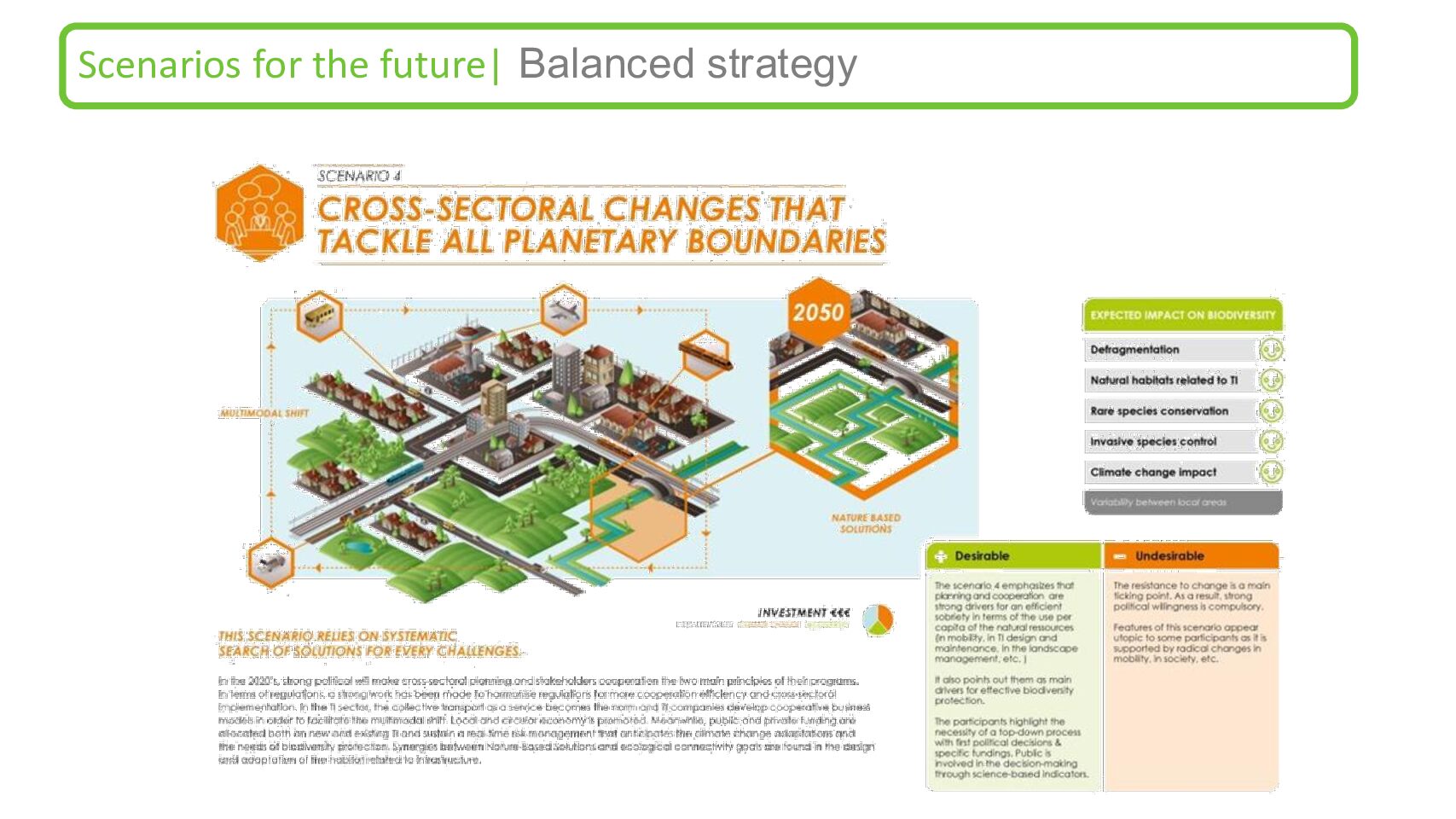
These scenarios showed that focusing solely on decarbonisation, without taking biodiversity into account, could worsen the overall ecological situation. The economic importance of biodiversity is also highlighted: 50 to 60% of global GDP depends directly on the health of biodiversity, contrasting with the minimal investment dedicated to it.
“Scenario 4, although difficult to implement, is the one we used to develop the strategic agenda delivered to the European Commission,” explains Sylvain Moulherat, co-founder, CEO and scientific director of TerrOïko, and president of A-IGÉco, who was closely involved in developing the study.
This SRDA agenda proposes two main areas of action to be implemented:
- transformative change in governance, regulation and public policy modes, “with finance being a big topic…”
- the main technical guidelines to be implemented in the field.
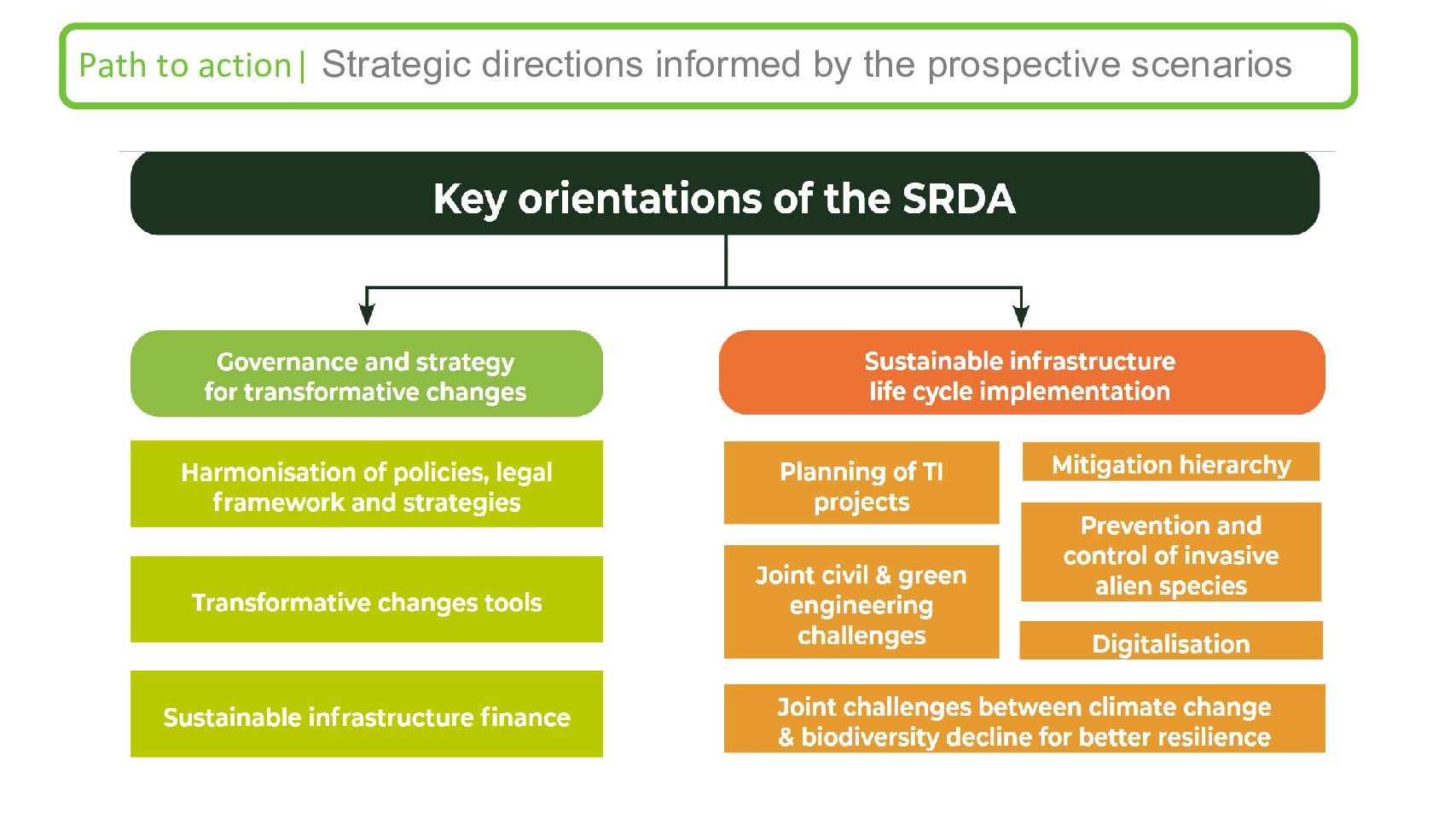
In addition to the deliverables, BISON has also published an online guide – BIODIVERSITY AND INFRASTRUCTURE: an online handbook for promoting cooperation and transformative change – to help transport and ecology stakeholders work together to realise more sustainable infrastructure development.
Mitigating the impacts of transport infrastructure: the Dutch experience
Edgar van der Grift, senior research ecologist at the Department of Animal Ecology, Wageningen University & Research, shared his feedback on the measures taken in the Netherlands, a country very much in advance of others in this field.
The Netherlands, which covers an area of 37,354 square kilometres, has a high density of approximately 3.5km of transport infrastructure (roads, railways, canals) per square kilometre, i.e. around 2.5% of the country is covered by such infrastructure. Based on these figures, since the 1990s, policymakers have realised urgent action is needed to tackle habitat fragmentation caused by such a high density of infrastructure, and ecological corridors or connections must be built to maintain at-risk wildlife populations.
Over the years, the construction of transport infrastructure in the Netherlands has resulted in the existence of small patches of habitats with “tiny, isolated populations that are at high risk of extinction,” explains Mr van der Grift. “Without connections, without corridors, they will simply disappear.”
“However, in the 1990s, everyone presented their own proposals, their own action plans,” he expands. “The provinces, municipalities, NGOs, landowners, various ministries, and all other stakeholders were working in silos. This made it extremely difficult to assess and compare the measures taken.”
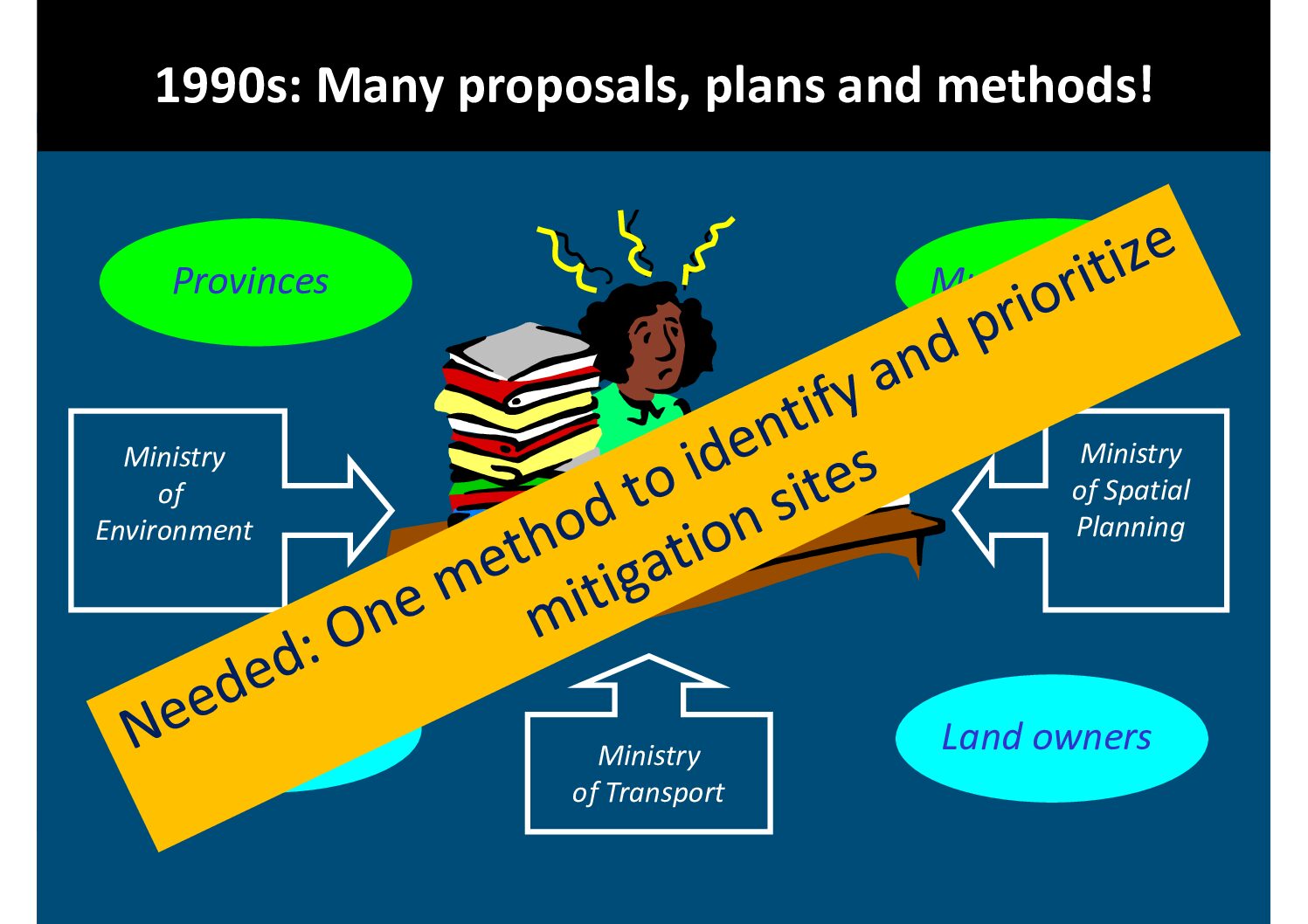
To resolve the issue, in 2004, the Dutch ministries of transport, environment, and spatial planning finally adopted a single method to be used by all. It is based on models for analysing the viability of populations across the territory. These models compare two scenarios (see image below), carried out species by species and for a certain number of selected species. On the left, existing transport infrastructure is mapped, on the right, it is all virtually removed from the landscape. “In other words, for the map on the right, we pretend that all roads, railways, and canals have been ‘mitigated’ and therefore no longer represent barriers to wildlife,” explains Mr van der Grift. “We then assess the habitats of the species in question and determine whether they are viable, highly viable, or simply non-viable. So these two maps provide a better understanding of what introducing mitigation measures would mean.”
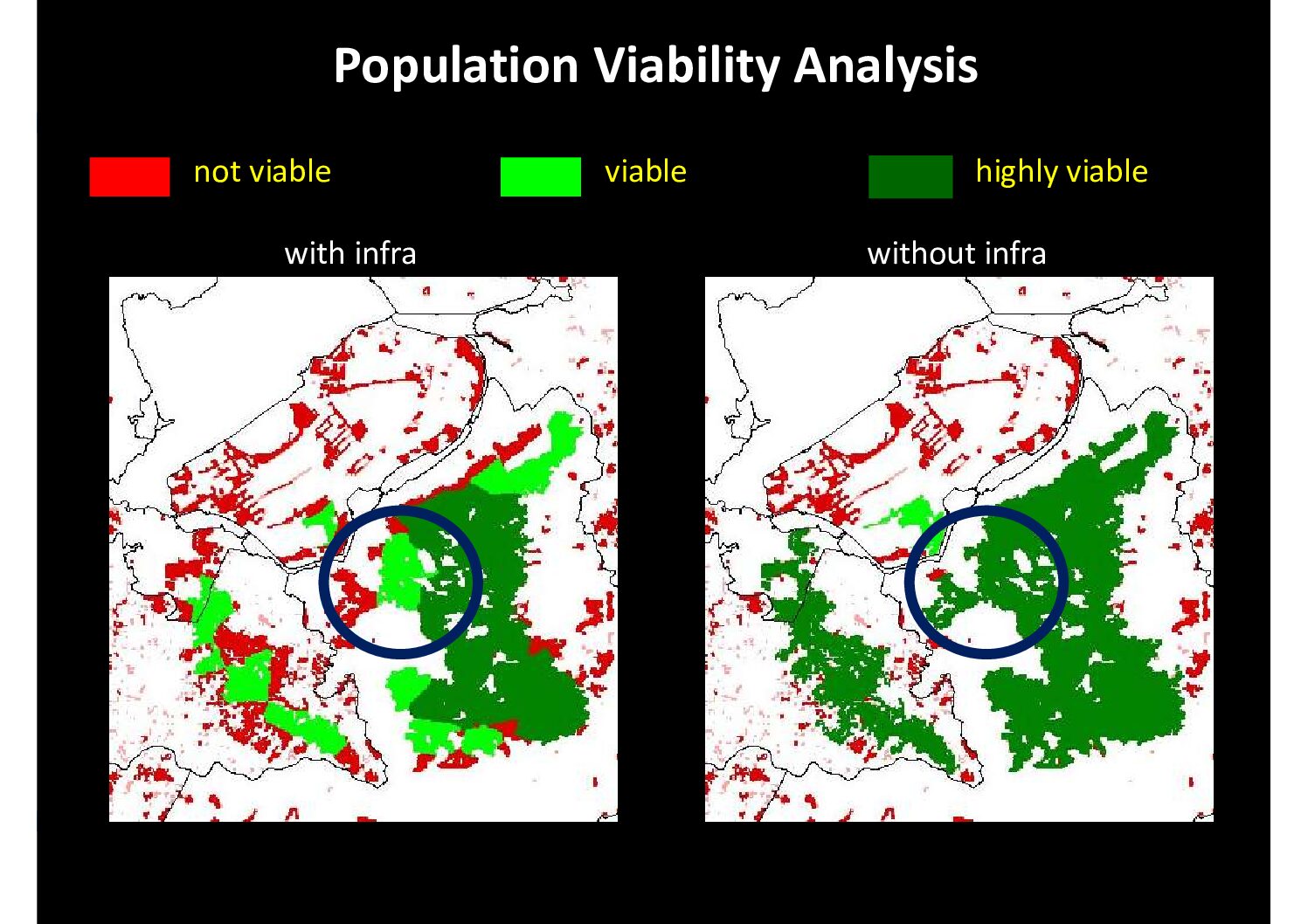
Thanks to these models, it is possible to identify the best locations for mitigation measures and define priorities for action based on the expected impacts of these measures on different species (number of species affected, size of populations concerned, etc).
Mitigation measures mainly consist of tunnels or wildlife bridges (small and large), fences, vegetation management, animal detection systems, and even signs to reduce traffic speeds or warn drivers to adapt the way they drive. In the Netherlands, around 2,500 tunnels have been built, ranging from small (25cm) to extremely large (>50m) – depending on the set of species that should be facilitated. It is important the passages themselves are habitats, so they should be vegetated “if possible, and bridges are preferable to tunnels.”
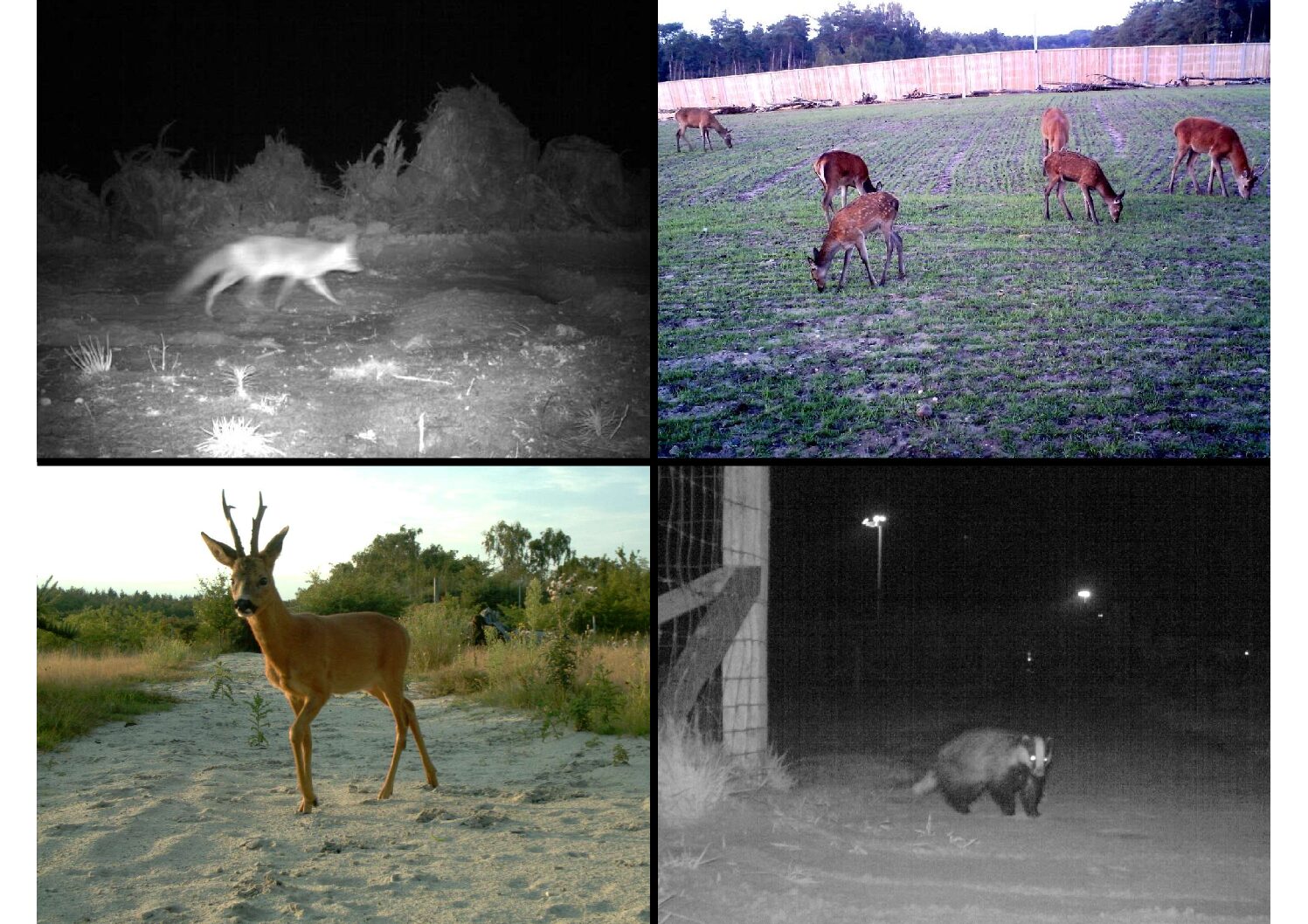
For roads, railways, and canals, Mr van der Grift insists on the importance of assessing the effectiveness of all measures introduced. “It is vital not only to check the structures are being used, but that the objectives for population viability are being met too.” Good indicators of the effectiveness of a measure are a reduction in collision mortality and, above all, in short, population growth of species and genetic exchange between subpopulations of the same species on either side of the infrastructure in question.
✈️ AVIATION
Biodiversity in airports: unexpected grasslands
Airports are home to vast expanses of natural or semi-natural grasslands. In France, they are composed of an average of 70% green space. These grasslands are often spared from the use of pesticides, thus acting as true refuges for fauna and flora. In the natural environment, grasslands are the easiest and least expensive type of land to build on, which is why they are in decline across Europe. In order to promote and protect biodiversity on these unique sites, the French association Aéro Biodiversité, founded in 2015, works to bring together aviation stakeholders and scientists to share knowledge and promote biodiversity at airport platforms.
“Airports and aerodromes in France – one of the countries with the most airfields – represent around 500 square kilometres of green space when you add up all their grasslands,” explains Hélène Abraham, director of Aéro Biodiversité.
Aéro Biodiversité works primarily on assessing the environmental quality of grasslands through participatory scientific protocols and promoting biodiversity through communication campaigns. The association also explores ways and means of improving biodiversity, for instance, by reducing the frequency and/or delaying mowing, raising mowing heights, or cutting down on the use of phytosanitary products, in strict compliance with aviation safety regulations in conjunction with the DGAC (Direction Générale de l’Aviation Civile, French civil aviation authority).
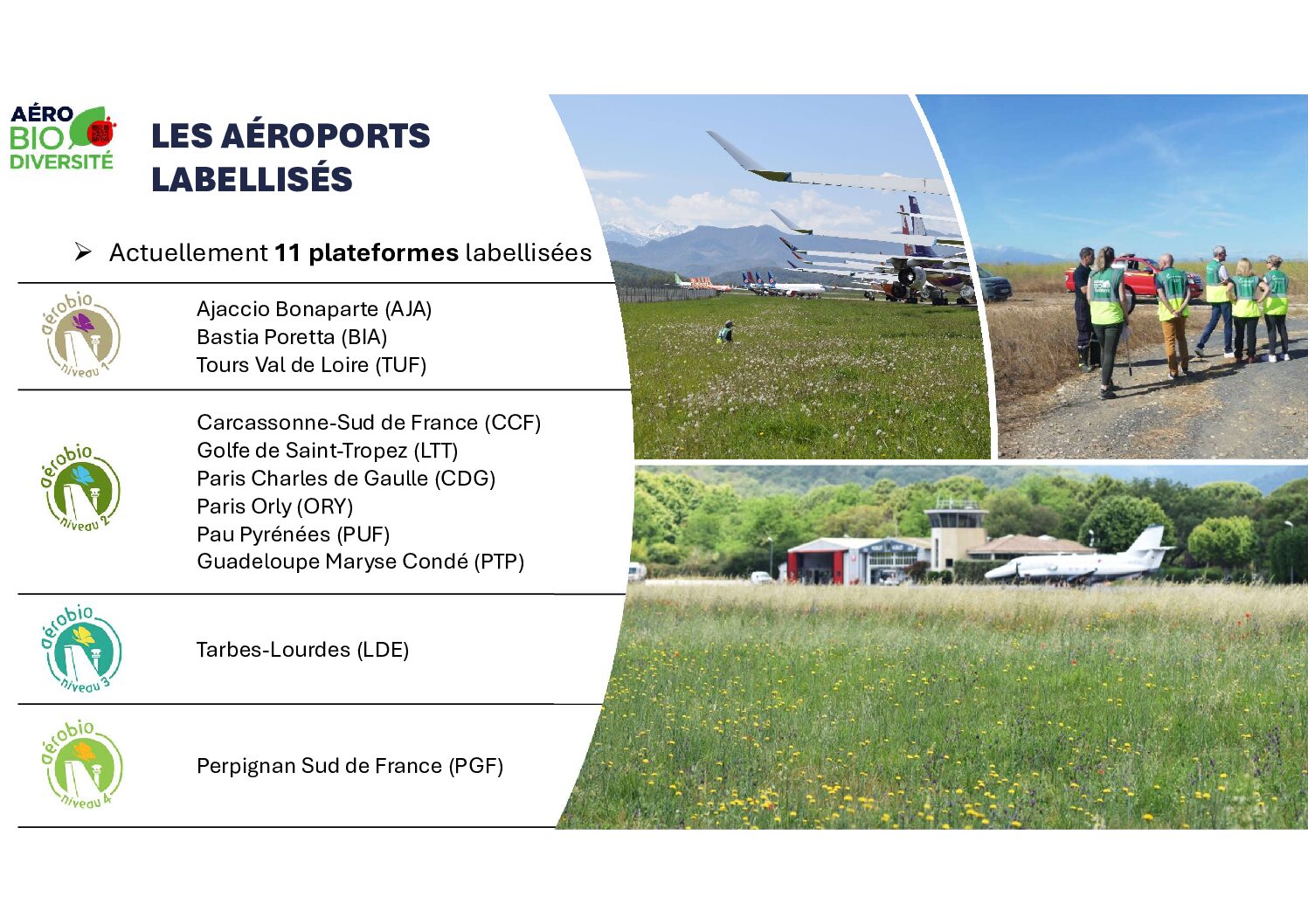
The ‘aerobio’ label (registered trademark) is awarded to airports for a period of five years in recognition of their work and commitments to the association’s approach. The assessment is based on multiple criteria such as biodiversity, how the airport is involved, communication, and regional anchorage. To date, 11 airports have received the label.
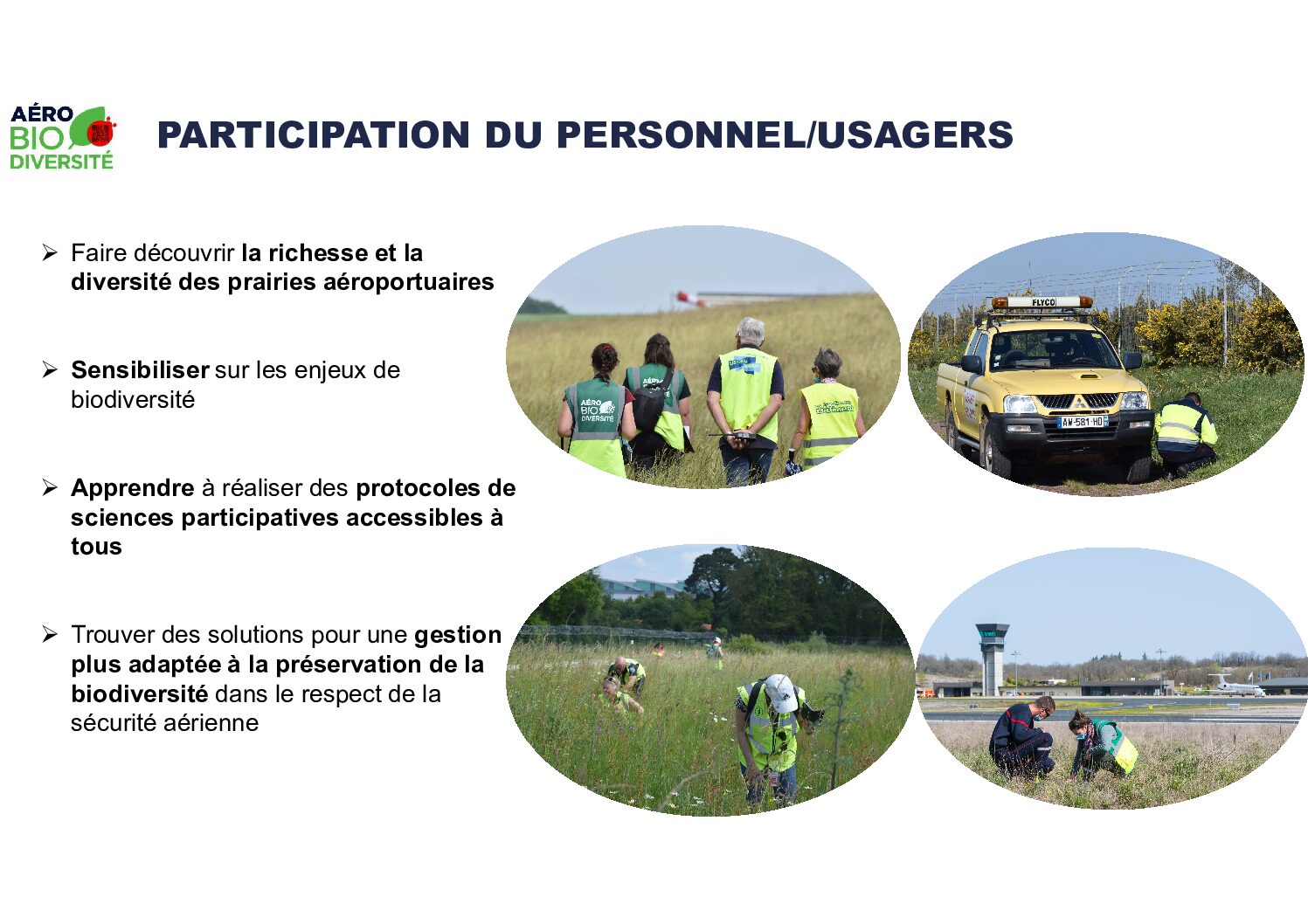
Preserving biodiversity is central to Groupe ADP‘s environmental commitment. Its airports in the Paris region cover more than 2,500 hectares of meadows and green spaces, which represent a major challenge in a densely urbanised area. The Group was one of the first stakeholders in the sector to work with Aéro Biodiversité. Today, its Paris-Orly and Paris-Charles de Gaulle airports are certified by the association.
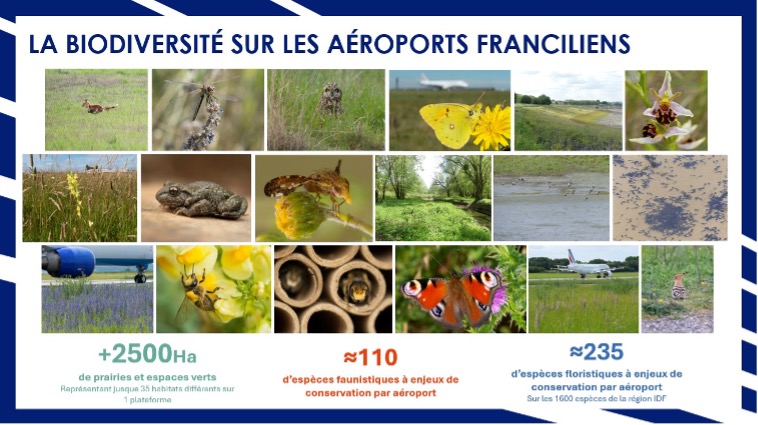
Groupe ADP’s commitments to biodiversity are based on four pillars:
- Preserving natural environments, with a commitment to dedicating 25% to 30% of space to biodiversity. The ecological management plan for green spaces includes a zero-pesticide approach, differentiated and, where possible, late mowing – once a year or even once every two years – as well as innovative scare tactics and renaturation measures to prevent the risk of collisions.
- Integrating biodiversity issues into the construction, renovation, and maintenance of infrastructure and real estate, which translates into selecting suitable materials, installing nesting boxes, and greening passenger walkways and rooftops.
- Mobilisation and awareness-raising among airport community stakeholders, in particular, awareness-raising actions for passengers in order to tackle wildlife trafficking.
- Integrating biodiversity at a strategic level, to improve the capacity for measuring financial risks linked to biodiversity, so as to take them into account in investment decisions, thereby aligning with international framework goals such as the Kunming-Montreal agreement.
“Since 2022, Groupe ADP has been measuring its biodiversity footprint – its biodiversity carbon footprint – which allows us to be more consistent by analysing our dependencies and impacts in greater detail. Hence we can take action on the most structural levers for nature conservation and plan for the long term,” explains Emilie Matjasic, biodiversity manager at Groupe ADP. “These assessments have led us to adopt a more holistic approach that is not limited to grassland management alone, but now, for instance, fully includes our construction practices,” she notes.
In addition, Groupe ADP is working to improve its knowledge of the biodiversity issues at each of its airports on an extremely local scale. Firstly, by carrying out comprehensive ecological assessments and additional voluntary inventories aimed at accurately identifying habitats and species of ecological interest – i.e. protected species, those classified on the red list, of community interest or of heritage importance – the data provided is made available to employees via interactive mapping to make it easier to use. The Group has also obtained a grant from the European Commission to design a more comprehensive dashboard for full monitoring of biodiversity at an airport, which could eventually be used at other airports in the sector.
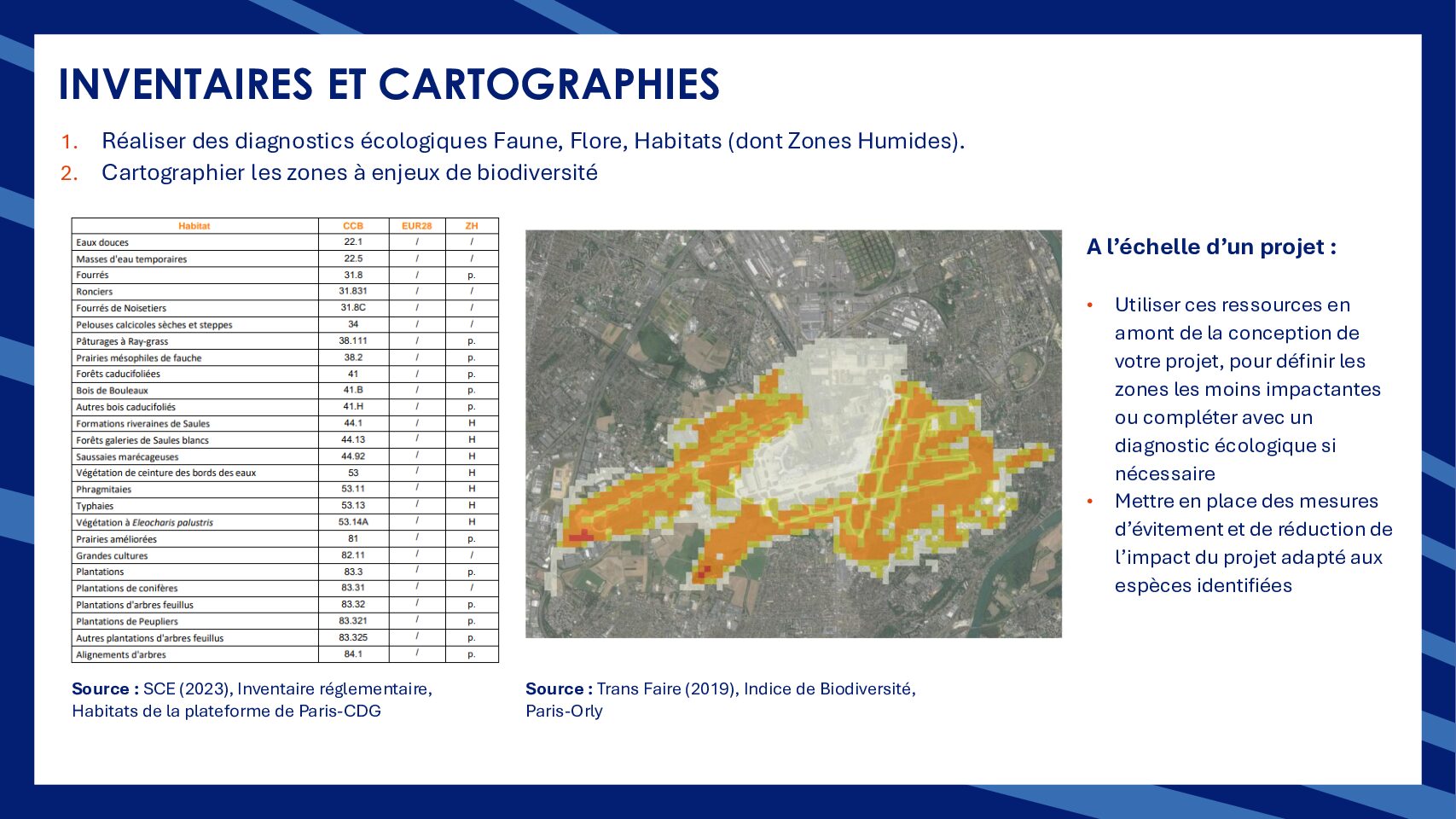
To demonstrate these efforts are indeed bearing fruit, Émilie Matjasic cites one of Groupe ADP’s success stories, that of the tree sparrow. A particularly endangered species, its population is declining by 15% per year worldwide. “It is in sharp decline in the Île-de-France region, where only eight colonies remain,” says Ms Matjasic. “And two of them coexist with our activities. One is nesting directly at Paris-Orly airport and the other has been located near Paris-Charles de Gaulle. Today, we are making numerous efforts to create an environment that favours its presence.”
Skills to be promoted at the highest level
This Futura-Mobility session demonstrated how skills and best practices have existed for many years in the field of biodiversity protection through transport systems.
Yet challenges remain, including the need to adopt a comprehensive approach across all planetary boundaries, to increase cooperation between stakeholders and sectors, to better anticipate in order to measure the real effectiveness of actions, and to fully integrate biodiversity – and other boundaries! – into corporate strategies, on the same level as climate objectives.
The economic quantification of the benefits provided by biodiversity remains a challenge… its relevance is currently under debate.
To be continued…

